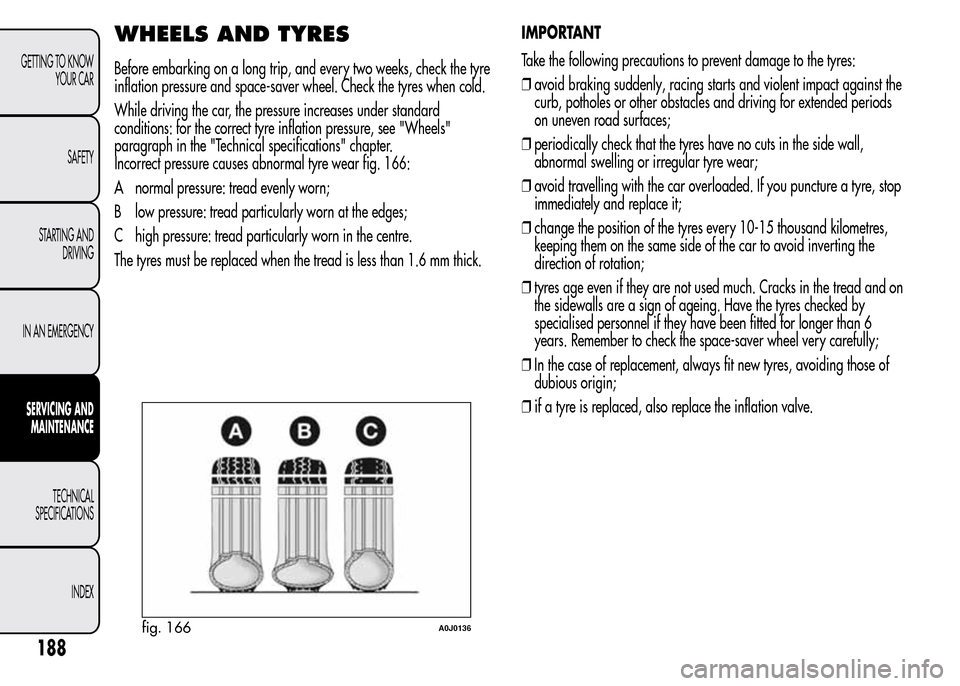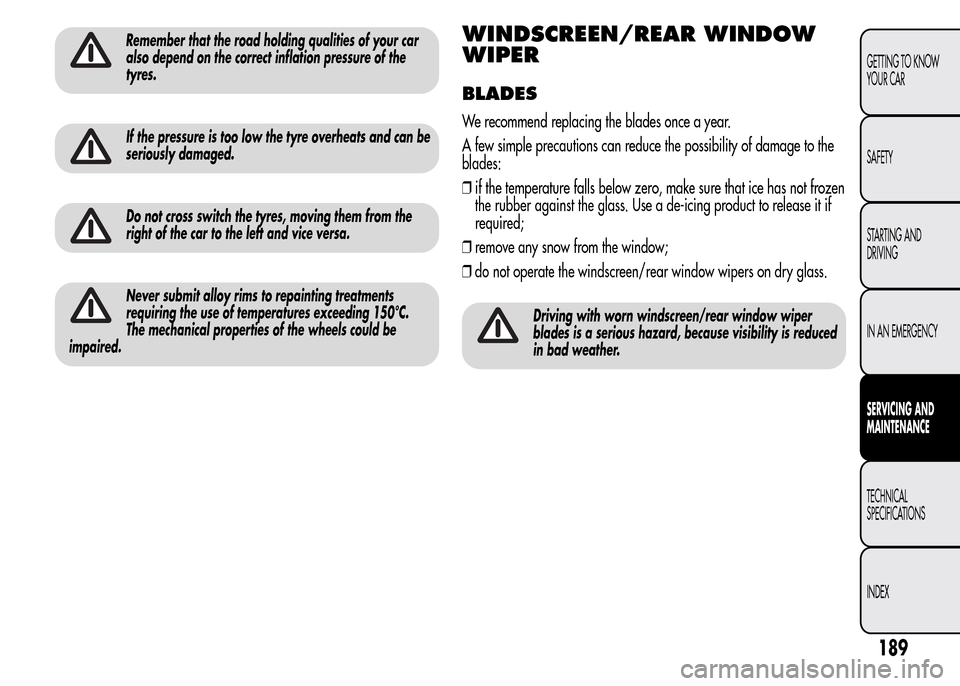2016 Alfa Romeo MiTo wheel
[x] Cancel search: wheelPage 148 of 280

❒use the wrench A fig. 120 provided to fully tighten the bolts in a
criss-cross fashion as per the numerical sequence illustrated in
fig. 123;
❒when replacing an alloy wheel it is advisable to place it upside
down, with the aesthetic part facing upwards.
Visit Alfa Romeo Authorized Services as soon as possible to
check the correct tightening of the main wheel bolts.
Restore the standard wheel as soon as possible, because, once placed
in the associated compartment, the luggage compartment load
platform is rendered uneven as the standard wheel is larger than the
space-saver wheel.
REMOVING THE SUBWOOFER
(versions with Bose HI-FI system)
(for versions/markets, where provided)
IMPORTANT The following procedure only applies to cars equipped
with Bose HI-FI systems with subwoofer (for versions/markets, where
provided).
Subwoofer and space-saver spare wheel
On these versions, the tools for replacing the wheel are located in a
dedicated bag in the luggage compartment.
Proceed as follows to remove the Subwoofer:
❒open the luggage compartment, pull tab A fig. 116 and lift up the
mat;
❒unscrew locking device A fig. 124, raise the subwoofer and then
remove connection cable B from the Velcro C;
fig. 123A0J0271fig. 124A0J0180
144
GETTING TO KNOW
YOUR CAR
SAFETY
STARTING AND
DRIVING
IN AN
EMERGENCY
SERVICING AND
MAINTENANCE
TECHNICAL
SPECIFICATIONS
INDEX
Page 149 of 280

❒rest the Subwoofer on one side in the luggage compartment, remove
the container and take the space-saver wheel;
❒replace the wheel as described previously.
At the end of the operation:
❒reposition the container (with the arrow pointing forwards) in its
housing and place the subwoofer on top of it, taking care to arrange
it according to the indications on the container (fig. 125) so that
the word “BOSE” is read in the correct position;
❒rest cable B fig. 124 on the Velcro C to avoid pinching it;
❒screw in locking device A, and finally lower the luggage
compartment mat.Subwoofer and "Fix&Go Automatic Kit"
Locating the Automatic Fix&Go Kit:
❒open the luggage compartment, pull tab A fig. 116 and lift up the
mat;
❒take the “Fix&Go Automatic Kit” located on the left side of the
luggage compartment ( fig. 126);
❒inflate the wheel (see paragraph entitled “Fix&Go Automatic Kit”).
fig. 125A0J0260fig. 126A0J0239
145
GETTING TO KNOW
YOUR CAR
SAFETY
STARTING AND
DRIVING
IN AN
EMERGENCY
SERVICING AND
MAINTENANCE
TECHNICAL
SPECIFICATIONS
INDEX
Page 150 of 280

REFITTING THE WHEEL
Following the procedure described previously, raise the car and
remove the small spare wheel.
Proceed as follows:
❒make sure the contact surfaces between standard wheel and hub are
clean so that the fastening bolts will not come loose;
❒for versions with steel rims: fix the hub cap on the rim,
aligning the crescent hole with the bolt you have fitted, then insert
the other 4 bolts;
❒tighten the retaining bolts using wrench A fig. 120;
❒lower the car and remove the jack;
❒use wrench A fig. 120 to fully tighten the bolts, following the
sequence illustrated in
❒for versions with alloy rims with hub cap: align the pin on
the cap with the housing on the rim.
At the end of operation
❒stow the space-saver spare wheel in the compartment provided in
the boot;
❒insert the jack and the other tools in the container;
❒arrange the container and tools on the space-saver wheel;
❒correctly reposition the boot mat.
"Fix&Go Automatic" kit
This is located in the luggage compartment.
The kit container also contains a screwdriver and the tow hook.
The kit also contains:
❒a bottle fig. 127 containing sealer and fitted with: filling tube B and
adhesive label C with the wording “max. 80 km/h” to be placed in
a clearly visible position (e.g. on the dashboard) after repairing
the tyre;
❒a compressor D complete with pressure gauge and connectors;
❒an information leaflet fig. 128, providing instructions for using the
kit correctly. This booklet should be given to the persons charged
with handling the tyre treated with this kit;
❒a pair of gloves located in the side compartment of the compressor;
❒adapters for inflating different elements.
IMPORTANT The sealing liquid is suitable for use at temperatures in the
range from –20°C to +50°C. The sealant has an expiry date.
fig. 127A0J0112
146
GETTING TO KNOW
YOUR CAR
SAFETY
STARTING AND
DRIVING
IN AN
EMERGENCY
SERVICING AND
MAINTENANCE
TECHNICAL
SPECIFICATIONS
INDEX
Page 151 of 280

Give the leaflet to the technicians who will be handling
the tyre that was treated using the "Fix&Go Automatic"
kit.
In the event of a puncture caused by foreign bodies, the kit
may be used to repair tyres showing damage on the track
or shoulder up to max 4 mm diameter.
Holes and damage on the tyre side walls cannot be
repaired. Do not use the tyre quick repair kit if the tyre
is damaged as a result of driving with it deflated.
Repairs are not possible in the case of damage to the
wheel rim (bad groove distortion causing air loss).
Do not remove foreign bodies (screws or nails) from
the tyre.
Never operate the compressor for longer than 20
consecutive minutes. Risk of overheating. The kit is not
suitable for definitive repairs, so the repaired tyres
may only be used temporarily.
Dispose of the bottle and the sealant liquid properly. Have
the sealing fluid and the cylinder disposed of in compliance
with national and local regulations.
The bottle contains ethylene glycol and latex: it may
cause an allergic reaction. It is harmful if swallowed. It
is irritant for the eyes in case of contact. There could
be a reaction in the event of inhalation or contact. Avoid contact
with the eyes, skin and clothes. In the event of contact, rinse
immediately with plenty of water. If ingested, do not induce
vomiting. Rinse out your mouth, drink large quantities of water
and seek immediate medical attention. Keep out of the reach
of children. The product must not be used by asthmatics. Do not
inhale the vapours during insertion and suction. Call a doctor
immediately if allergic reactions are noted. Store the bottle in the
specific compartment, away from sources of heat. The sealant
fluid has an expiry date. Replace the bottle containing out-of-
date sealant fluid.
fig. 128A0J0113
147
GETTING TO KNOW
YOUR CAR
SAFETY
STARTING AND
DRIVING
IN AN
EMERGENCY
SERVICING AND
MAINTENANCE
TECHNICAL
SPECIFICATIONS
INDEX
Page 152 of 280

INFLATION PROCEDURE
Wear the protective gloves provided with the kit.
Proceed as follows:
❒engage the handbrake, unscrew the tyre valve cap, take out the
flexible filler pipe A fig. 129 and tighten the ring nut B on the tyre
valve;
❒make sure that switch A fig. 130 for the compressor is in position 0
(off), start the engine, insert the plug A fig. 131 into the power
socket on the central tunnel and switch on the compressor by
bringing switch A fig. 130 to position I (on);❒inflate the tyre to the pressure indicated in the “Wheels” paragraph
in the “Technical specifications” section. In order to obtain a more
precise reading, check the pressure value on pressure gauge B
fig. 130 with the compressor off;
fig. 129A0J0214
fig. 130A0J0114
fig. 131A0J0116
148
GETTING TO KNOW
YOUR CAR
SAFETY
STARTING AND
DRIVING
IN AN
EMERGENCY
SERVICING AND
MAINTENANCE
TECHNICAL
SPECIFICATIONS
INDEX
Page 174 of 280

Before beginning to tow, turn the ignition key to MAR
and then to STOP, without extracting it The steering
column will automatically lock when the key is
removed and the wheels cannot be steered.
Remember that whilst towing it is necessary to exert a
greater force when steering and braking because the
brake servo and electro-mechanical power steering
will be inoperative. Do not use wires for towing. Do not jerk. Be
careful not to damage parts in contact with the car while towing.
When towing the vehicle, you must comply with all specific traffic
regulations and adopt an appropriate driving behaviour. Do not
start the engine while towing the car. Clean the threaded seat
carefully before fastening the hook. Make sure that the hook is
fully fastened in the housing before towing the car.
The front and rear tow hooks should be used only for
emergencies on the road. You are allowed to tow the
vehicle for short distances using an appropriate device
in accordance with the highway code (a rigid bar), to move the
vehicle on the road in readiness for towing or transport via a
breakdown vehicle. Tow hooks MUST NOT be used to tow
vehicles off the road or where there are obstacles and/or for
towing operations using cables or other non-rigid devices.
Respecting the above conditions, towing must take place with the
two vehicles (one towing, the other towed) aligned as much as
possible along the same centre line.
170
GETTING TO KNOW
YOUR CAR
SAFETY
STARTING AND
DRIVING
IN AN
EMERGENCY
SERVICING AND
MAINTENANCE
TECHNICAL
SPECIFICATIONS
INDEX
Page 192 of 280

WHEELS AND TYRES
Before embarking on a long trip, and every two weeks, check the tyre
inflation pressure and space-saver wheel. Check the tyres when cold.
While driving the car, the pressure increases under standard
conditions: for the correct tyre inflation pressure, see "Wheels"
paragraph in the "Technical specifications" chapter.
Incorrect pressure causes abnormal tyre wear fig. 166:
A normal pressure: tread evenly worn;
B low pressure: tread particularly worn at the edges;
C high pressure: tread particularly worn in the centre.
The tyres must be replaced when the tread is less than 1.6 mm thick.IMPORTANT
Take the following precautions to prevent damage to the tyres:
❒avoid braking suddenly, racing starts and violent impact against the
curb, potholes or other obstacles and driving for extended periods
on uneven road surfaces;
❒periodically check that the tyres have no cuts in the side wall,
abnormal swelling or irregular tyre wear;
❒avoid travelling with the car overloaded. If you puncture a tyre, stop
immediately and replace it;
❒change the position of the tyres every 10-15 thousand kilometres,
keeping them on the same side of the car to avoid inverting the
direction of rotation;
❒tyres age even if they are not used much. Cracks in the tread and on
the sidewalls are a sign of ageing. Have the tyres checked by
specialised personnel if they have been fitted for longer than 6
years. Remember to check the space-saver wheel very carefully;
❒In the case of replacement, always fit new tyres, avoiding those of
dubious origin;
❒if a tyre is replaced, also replace the inflation valve.
fig. 166A0J0136
188
GETTING TO KNOW
YOUR CAR
SAFETY
STARTING AND
DRIVING
IN AN EMERGENCY
SERVICING AND
MAINTENANCE
TECHNICAL
SPECIFICATIONS
INDEX
Page 193 of 280

Remember that the road holding qualities of your car
also depend on the correct inflation pressure of the
tyres.
If the pressure is too low the tyre overheats and can be
seriously damaged.
Do not cross switch the tyres, moving them from the
right of the car to the left and vice versa.
Never submit alloy rims to repainting treatments
requiring the use of temperatures exceeding 150°C.
The mechanical properties of the wheels could be
impaired.
WINDSCREEN/REAR WINDOW
WIPER
BLADES
We recommend replacing the blades once a year.
A few simple precautions can reduce the possibility of damage to the
blades:
❒if the temperature falls below zero, make sure that ice has not frozen
the rubber against the glass. Use a de-icing product to release it if
required;
❒remove any snow from the window;
❒do not operate the windscreen/rear window wipers on dry glass.
Driving with worn windscreen/rear window wiper
blades is a serious hazard, because visibility is reduced
in bad weather.
189
GETTING TO KNOW
YOUR CAR
SAFETY
STARTING AND
DRIVING
IN AN EMERGENCY
SERVICING AND
MAINTENANCE
TECHNICAL
SPECIFICATIONS
INDEX